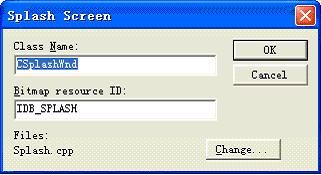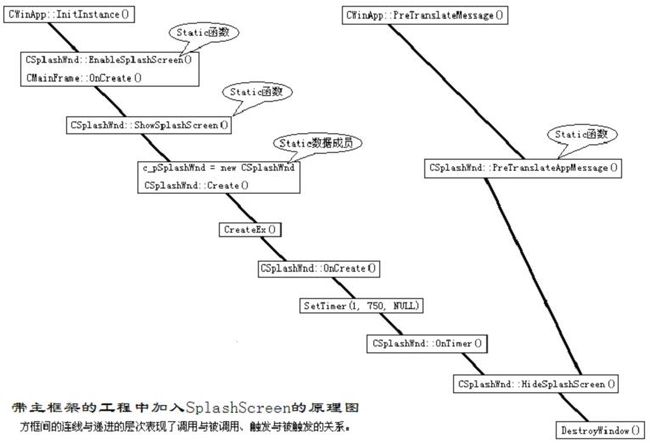VC2010工程中加入SplashScreen及原理释解
一、VC2010中使用CSplashWnd类
由于VC2010中不能插入组件,只有手动添加CSplashWnd类,该类的代码可以由以前VC6.0的代码复制过来。添加该类后,以SDI或者MDI为例,使用CSplashWnd类的具体方法如下:
(1)在CWinApp::InitInstance()中调用CSplashWnd::EnableSplashScreen()设置c_bShowSplashWnd;
代码如下:
BOOL CDrawApp::InitInstance()
{
//用来处理是否显示SplashScreen
{
CCommandLineInfo cmdinfo;
ProcessShellCommand(cmdinfo);
CSplashWnd::EnableSplashScreen(cmdinfo.m_bShowSplash);
}
………..
}
(2)在PreTranslateMessage()中调用CSplashWnd::PreTranslateAppMessage(),将键盘和鼠标消息传递给CSplashWnd对象
代码如下:
//该函数为虚函数,需要重写
BOOL CDrawApp::PreTranslateMessage(MSG* pMsg)
{
if (CSplashWnd::PreTranslateAppMessage(pMsg))
return TRUE;
return CWinAppEx::PreTranslateMessage(pMsg);
}
(3)在CMainFrame对象的OnCreate()中调用CSplashWnd::ShowSplashScreen()创建一个静态的SplashScreen窗口对象c_pSplashWnd,并设置其父窗口为CMainFrame.
代码如下:
int CMainFrame::OnCreate(LPCREATESTRUCT lpCreateStruct)
{
if (CMDIFrameWndEx::OnCreate(lpCreateStruct) == -1)
return -1;
………..
CSplashWnd::ShowSplashScreen(this);//创建一个静态的SplashScreen窗口对象
return 0;
}
需要注意的是,在上述过程中不会出现什么错误,但编译时会提示:IDB_SPLASH没有定义。这需要在资源中加入一个位图资源,并将其ID改为IDB_SPLASH,同时也要将”resource.h” 头文件包含到CSlashWnd.cpp文件中。插入的这个位图资源就是我们的启动画面。
上述方法转自文章:《VC++2010工程中加入SplashScreen》http://www.cnblogs.com/luoshupeng/archive/2011/09/16/2178449.html
示例代码:http://download.csdn.net/detail/luoshupeng/3606489
二、VC++工程中加入 SplashScreen 的原理
摘要
本文旨在剖析VC++工程中加入 SplashScreen 的原理,并给出在VC++ MFC(exe)工程中加入 SplashScreen 的步骤。
关键字:SplashScreen,原理
环境:Windows 98SE/2000,VC++ 6.0
SplashScreen - 我们使用 Word 之类的软件在启动的短暂时间里就会看到它的身影。它通常用以在程序启动时显示程序及用户名称,版权信息等。我也不知道它准确的名称是什么(是闪屏吗?),就这样称呼吧。也许你也想在自己的工程里加入这样的特性,本文将以创建实际工程的方式逐步剖析其实现原理。
注意:为避免实际所使用工程名给类或对象名带来的干扰,除非特别说明,在本文中将使用基类名如CWinApp、CMainFrame、CDialog来代替实际工程中的相应派生类名进行描述。
Visual C++是一个相当强大的C++开发工具,它内嵌了对SplashScreen的支持。但是在MFC EXE类型工程中只是对带有主框架类的SDI或MDI工程提供了这一支持,基于对话框类的工程则被排除在外。现在让我们开始吧。第一步是在SDI工程中加入SplashScreen。
首先利用AppWizard生成一个SDI工程,除了其中Docking ToolBar必须选择外(我认为这是MFC的一个Bug,当然这与本文讨论的SplashScreen没有关系),其他的文档-视图支持、状态条之类的都可以不要,这样可以尽量减少无用的代码。
通过IDE中的菜单Project->Add to Project->Components and Controls,我们就可以从Visual C++ Components中选择Splash Screen这个组件插入工程。
在点击了"Insert"后会弹出一个如下图所示的对话框,这是设置插入该工程中的SplashScreen的类名、显示用位图的ID及文件名,采用缺省值即可。
通过以上几步的操作,就会在工程目录下生成Splash.CPP和Splash.H文件,这便是CSplashWnd类的实现文件与头文件。同时工程中CWinApp与CMainFrame类中的部分代码也会被修改,以实现CSplashWnd窗口的消息处理。
接着我们来看看 CSplashWnd 类的声明与主要的代码(已经过删减):
//类的声明
class CSplashWnd : public CWnd
{
CSplashWnd();
~CSplashWnd();
virtual void PostNcDestroy();
static void EnableSplashScreen(BOOL bEnable = TRUE);
static void ShowSplashScreen(CWnd* pParentWnd = NULL);
static BOOL PreTranslateAppMessage(MSG* pMsg);
BOOL Create(CWnd* pParentWnd = NULL);
void HideSplashScreen();
afx_msg int OnCreate(LPCREATESTRUCT lpCreateStruct);
afx_msg void OnPaint();
afx_msg void OnTimer(UINT nIDEvent);
CBitmap m_bitmap; //SplashScreen窗口显示用的位图对象
static BOOL c_bShowSplashWnd; //是否要显示SplashScreen的标志量
static CSplashWnd* c_pSplashWnd;
};
//是否使用SplashScreen
void CSplashWnd::EnableSplashScreen(BOOL bEnable)
{
c_bShowSplashWnd = bEnable;
}
//创建CsplashWnd对象,并调用Create()创建窗口
void CSplashWnd::ShowSplashScreen(CWnd* pParentWnd)
{
//如果不要显示SplashScreen或SplashWnd对象已经被创建则返回
if (!c_bShowSplashWnd || c_pSplashWnd != NULL)
return;
c_pSplashWnd = new CSplashWnd;
if (!c_pSplashWnd->Create(pParentWnd))
delete c_pSplashWnd;
else
c_pSplashWnd->UpdateWindow();
}
//装入SplashScreen欲显示位图,通过CreateEx()激发OnCreate()完成窗口创建与设置
BOOL CSplashWnd::Create(CWnd* pParentWnd)
{
if (!m_bitmap.LoadBitmap(IDB_SPLASH))
return FALSE;
BITMAP bm;
m_bitmap.GetBitmap(&bm);
return CreateEx(0,
AfxRegisterWndClass(0,AfxGetApp()->LoadStandardCursor(IDC_ARROW)),
NULL,
WS_POPUP | WS_VISIBLE,
0,
0,
bm.bmWidth,
bm.bmHeight,
pParentWnd->GetSafeHwnd(),
NULL);
}
//销毁窗口,刷新框架
void CSplashWnd::HideSplashScreen()
{
DestroyWindow();
AfxGetMainWnd()->UpdateWindow();
}
//利用窗口创建结构创建窗口,并设置定时器在750ms后触发OnTimer()
int CSplashWnd::OnCreate(LPCREATESTRUCT lpCreateStruct)
{
if (CWnd::OnCreate(lpCreateStruct) == -1)
return -1;
CenterWindow(); //窗口居中显示
SetTimer(1, 750, NULL); //设置定时器
return 0;
}
//将键盘和鼠标消息传递给CSplashWnd对象,以销毁窗口
BOOL CSplashWnd::PreTranslateAppMessage(MSG* pMsg)
{
if (c_pSplashWnd == NULL)
return FALSE;
if (pMsg->message == WM_KEYDOWN ||
pMsg->message == WM_SYSKEYDOWN ||
pMsg->message == WM_LBUTTONDOWN ||
pMsg->message == WM_RBUTTONDOWN ||
pMsg->message == WM_MBUTTONDOWN ||
pMsg->message == WM_NCLBUTTONDOWN ||
pMsg->message == WM_NCRBUTTONDOWN ||
pMsg->message == WM_NCMBUTTONDOWN)
{
c_pSplashWnd->HideSplashScreen();
return TRUE;
}
return FALSE;
}
void CSplashWnd::OnTimer(UINT nIDEvent)
{
HideSplashScreen();
}
再看看CWinApp和CMainFrame类中发生了什么样的改变:
(1)在CWinApp::InitInstance()中调用CSplashWnd::EnableSplashScreen()设置c_bShowSplashWnd;
在PreTranslateMessage()中调用CSplashWnd::PreTranslateAppMessage(),将键盘和鼠标消息传递给CSplashWnd对象,从而进一步调用CSplashWnd::HideSplashScreen()实现SplashScreen窗口的自身销毁。
(2)在CMainFrame对象的OnCreate()中调用CSplashWnd::ShowSplashScreen()创建一个静态的SplashScreen窗口对象c_pSplashWnd,并设置其父窗口为CMainFrame。在这个过程中,CSplashWnd自身会通过创建来设置一个定时器,然后定时器在第一个周期触发时便调用HideSplashScreen()销毁自己。
(3) 而CMainFrame对象的窗口创建消息则是由CWinApp对象在InitInstance()中通过
m_pMainWnd->ShowWindow()调用触发的。
整个过程可以用下图表示,基本原理就是由CMainFrame来创建CSplashWnd,然后由CSplashWnd自己的定时器触发定时消息来销毁窗口。所以 CSplashWnd 的加入与SDI还是MDI都没有关系。
第二步,我们再来看看如何在基于对话框的工程中加入 SplashScreen。
通过对以上SDI工程中加入SplashScreen原理的剖析,我想大家也想到如何在基于对话框的工程中加入这一特性了。其实质就是由CDialog类完成SDI工程中CMainFrame类的工作,实现步骤如下:
(1)利用ClassWizard为CMyDialog添加WM_CREATE消息的处理函数OnCreate();(这里使用CMyDialog是为了与函数内的基类名CDialog区别。)
int CMyDialog::OnCreate(LPCREATESTRUCT lpCreateStruct)
{
if (CDialog::OnCreate(lpCreateStruct) == -1)
return -1;
CSplashWnd::ShowSplashScreen(this);
return 0;
}
(2)利用ClassWizard为CWinApp添加消息转发处理函数PreTranslateMessage();
BOOL CWinApp::PreTranslateMessage(MSG* pMsg)
{
if (CSplashWnd::PreTranslateAppMessage(pMsg))
return TRUE;
return CWinApp::PreTranslateMessage(pMsg);
}
(3)CWinApp::InitInstance()中加入如下调用: CSplashWnd::EnableSplashScreen(TRUE);
(4)当然你还需要将上一个SDI工程中生成的Splash.CPP与Splash.H文件拷贝到当前工程目录下,并利用Project->Add to Project->Files将这两个文件引入工程。同时还要在CWinApp与CMainFrame的实现文件中#include "Splash.H"。
(5)然后在资源管理器里添加一个ID为IDB_SPLASH的位图。由于VC++的IDE只能显示256色以下的位图,所以如果你想显示一幅真彩色的位图,就请用Import方式导入一幅预先制作好的位图。当然VC++会提示位图已经成功导入,只是无法在IDE的位图编辑器中显示,而在程序运行时就会显示了。如果你想象Word那样显示用户名等信息,可以在CSplashWnd::Create()中装载位图之后增加自己的代码来修改位图。
通过以上这几步操作,我们就完成了在基于对话框的工程中加入SplashScreen的工作。
上述文章转自:http://www.bianceng.cn/Programming/vc/201005/17004.htm


